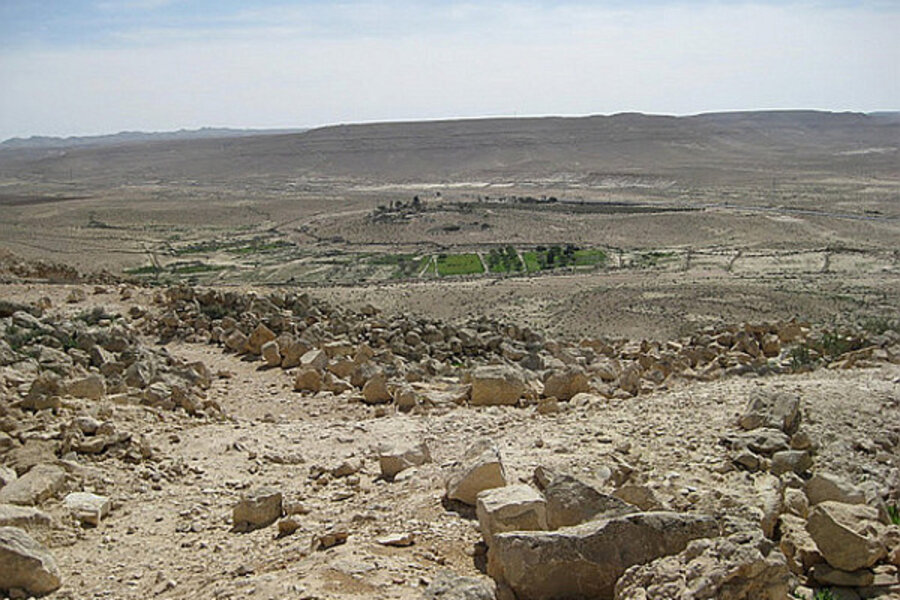Rewriting Biblical history? Agriculture might be 5,000 years older than believed.
Loading...
| AVDAT, Israel
For thousands of years, different groups of people have lived in the Negev desert, building stone walls and cities that survive to this day. But how did they make their living?
The current thinking is that these desert denizens didn't practice agriculture before approximately the first century, surviving instead by raising animals, said Hendrik Bruins, a landscape archaeologist at Ben-Gurion University of the Negev.
But new research suggests people in this area, the Negev highlands, practiced agriculture as long ago as 5000 B.C., Bruins told LiveScience. If true, the finding could change historians' views of the area's inhabitants, who lived in the region in biblical times and even before, he added.
A great surprise
Bruins' findings come from radiocarbon dating of bones and organic materials in various soil layers in an ancient field in southern Israel. He measured the ratio of carbon isotopes (atoms of the same element with a different number of neutrons), which changes as the radioactive carbon-14 isotope breaks down over time, while the stable carbon-12 does not. Within the soil, he found evidence of past cultivation, including animal manure and charred organic material (likely burnt kitchen scraps), both of which have been used as fertilizer around the world for millennia, he said. (Carbon dating has been used to date famous objects, such as the Dead Sea Scrolls).
"I found a wonderful radiocarbon sequence of ages," Bruins said. "And it was for me a great surprise."
He found three distinct layers in the earth indicating that the field had been cultivated, corresponding to three different periods of activity, with long gaps in between. The first one dated from 5000 B.C. to 4500 B.C., followed by another from 1600 B.C. to 950 B.C. and a final layer dating from A.D. 650 to A.D. 950.
The first group of people that farmed here has no current known name, he said, but developed flint tools that have been found throughout the region.
The Exodus
The second period of agriculture, from 1600 B.C. to 950 B.C., corresponds to the time in which the Jews made their way from Egypt to modern-day Israel, according to Exodus and other books of the Bible, Bruins said.
The site where Bruins conducted his research, south of Beersheba, is likely to the south and east of where historians place the Israelites during this time period, he said. But it could possibly have been home to tribes associated with the Amalekites, a group living in the area at the time that was hostile to the Israelites, Bruins said.
The third layer corresponds to the late Byzantine and early Islamic period, when people were known to practice agriculture in this area, he added.
Bruins is currently submitting his research to a peer-reviewed scientific journal; it hasn't yet been published.
Graeme Barker, a researcher at the University of Cambridge, said that without having a peer-reviewed paper, it's difficult to tell how important the finding may be. However, if the research does indeed prove that agriculture has been practiced in the area since 5000 B.C., that finding would be "great, and important."
A lot of archaeological work has been conducted in the area, but analysis of stones and pottery has limitations when it comes to agriculture, Bruins said. "There is widespread evidence of ancient floodwater farming in the southern Levant in the form of drystone walls across and along wadis (valleys), but whilst there is an enormous literature about the likely periods of the past to which they belong, most of this is speculative… and in principle, examples of floodwater farming structures could date anywhere in time from the Neolithic to the 20th century," Barker wrote in an email to LiveScience.
These desert peoples used walls and ditches to collect rainwater during the area's infrequent rainfalls. Later inhabitants of the area, known as the Nabataeans, are known for their skill at collecting and conserving rainwater, which allowed them to establish and run a thriving trade route through the area before the arrival of the Romans, who eventually displaced the Nabataeans, Bruins said.
Ancient farms, like those in the region today, likely cultivated vineyards, olives, wheat and barley, he said.
Editor's Note: This story was generated during a trip paid for by American Associates, Ben-Gurion University of the Negev.
Email Douglas Main or follow him @Douglas_Main. Follow us @livescience, Facebook or Google+. Original article on LiveScience.com.
- In Photos: Amazing Ruins of the Ancient World
- Stark Beauty: Images of Israel's Negev Desert
- 10 Driest Places on Earth
Copyright 2013 LiveScience, a TechMediaNetwork company. All rights reserved. This material may not be published, broadcast, rewritten or redistributed.





